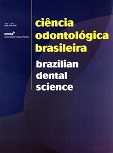Estudo clínico comparativo entre cirurgia convencional e a radiação laser Co2 em fenômeno de retenção de muco
DOI:
https://doi.org/10.14295/bds.2006.v9i1.273Abstract
O objetivo deste estudo foi avaliar o aspecto clínico entre o tratamento cirúrgico convencional e a laser de dióxido de carbono (CO2) em fenômeno de retenção de muco (FRM). Foram constituídos dois grupos de pacientes, num total de vinte e quatro. Grupo I (biópsia convencional) com nove pacientes adultos, tratados através de cirurgia do tipo biópsia excisional. Grupo II (radiação laser) com quinze pacientes adultos tratados através de vaporização a laser, em modo contínuo, foco de 0,6mm de diâmetro, 2 Watts de potência, Densidade de potência (=Intensidade) de 256 W/cm2, fluência de 0,077 J/cm2. Os dados obtidos foram analisados estatisticamente pelos métodos de Teste de Permutação Exata, Teste Exato de Fisher e análise percentual. As cirurgias em lesões do tipo FRM tratados com laser de CO2 apresentaram melhores resultados do que àquelas realizadas através de cirurgia convencional. Os pacientes submetidos à vaporização com laser de CO2 apresentaram ausência de hemorragia e/ou diminuição da dor e edema, assim como a desnecessidade de sutura. Comparada ao método convencional, a cirurgia com laser de CO2 requer menor tempo de trabalho constituindo uma excelente vantagem. Entretanto, o aspecto clínico final das biópsias nos dois grupos não apresentou diferenças significativas.Downloads
Downloads
Published
How to Cite
Issue
Section
License
Brazilian Dental Science uses the Creative Commons (CC-BY 4.0) license, thus preserving the integrity of articles in an open access environment. The journal allows the author to retain publishing rights without restrictions.
=================




























